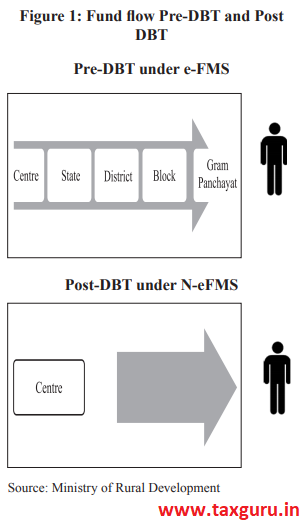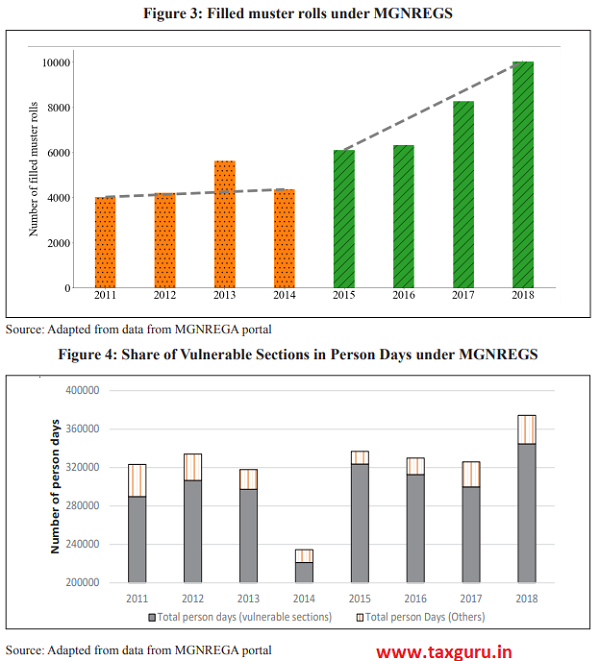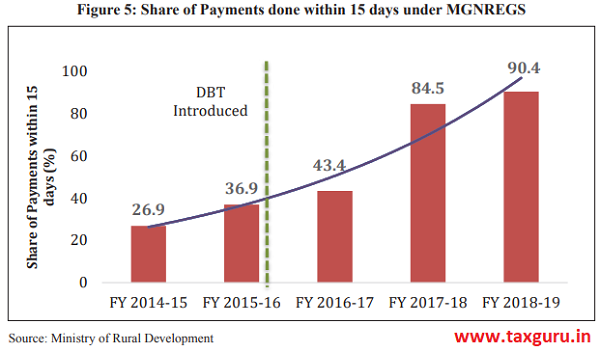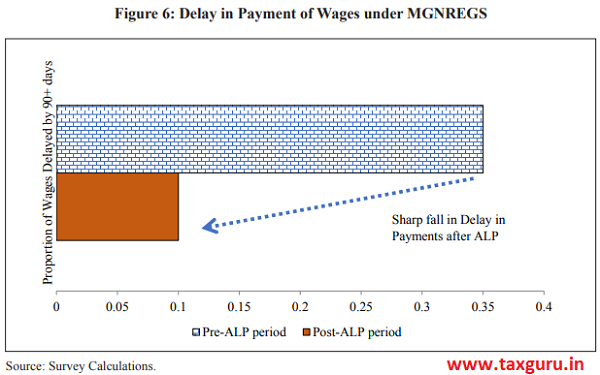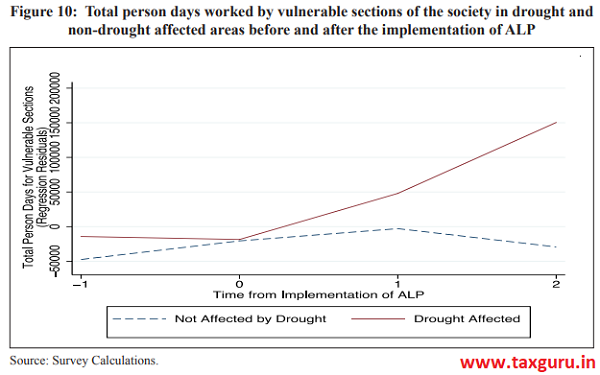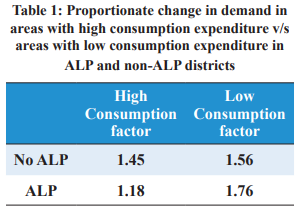Work gets accomplished by putting in effort,
and certainly not by mere wishful thinking
While MGNREGS was made effective from 2006, the streamlining of the programme occurred in 2015 when the government harnessed the benefits of technology. This, inter alia, included the implementation of Direct Benefit Transfer (DBT) and linking it Aadhar linked Payments (ALP). It leveraged the Jan Dhan, Aadhaar and Mobile (JAM) trinity to credit wages directly into MGNREGS workers’bank accounts, thereby reducing scope for delays in payment. This chapter highlights the benefits of careful and effective targeting of government programmes by demonstrating that DBT-enabled MGNREGS has indeed helped to alleviate distress of workers. Post DBT payment delays in the payment of wages, under MGNREGS, has reduced significantly thereby providing livelihood security to people in distress. Both demand and supply of work under MGNREGS increased, especially in districts suffering from distress. The increase in the number of filled muster rolls also implies that distressed workers indeed turn up more frequently for work. The importance of ALP-enabled MGNREGS in alleviating distress is particularly pronounced for the vulnerable sections of society, including women, persons with disability, Scheduled Castes and Scheduled Tribes. As data on demand for work under MGNREGS is available almost real-time, it can be developed into a real-time measure to track distress at the level of a district/panchayat. This evidence highlights that skilful use of technology when combined with an unwavering commitment to monitoring effectiveness of government schemes can make a substantial difference on the ground.
INTRODUCTION
10.1 Today’s workforce programs, which are popularly used across the world to alleviate distress and poverty, owe their intellectual origins to “food for work” programs during the rule of Chandragupta Maurya (320 BC to 298 BC). In fact, as acknowledged by Drekmeier (1962), “food for work” is first referred in Kautilya’s Arthashastra. Much later in 1784, but more than a century before Keynes (1909), Nawab Asaf-ud-Daula started a “food for work” programme to help the famine-stricken people of Lucknow. Some workers were employed during daytime to construct the Imambara. Others were hired at night to demolish part of what was constructed during the day time. The Mahatma Gandhi National Rural Employment Guarantee Act (MGNREGA), which was enacted through an Act of Parliament in 2005, represents the modern version of such “food for work” programmes in India.
10.2 The programme was operationalized through the Mahatma Gandhi National Rural Employment Guarantee Scheme (MGNREGS) with effect from February 2, 2006. The programme was initiated to ameliorate rural distress by providing at least 100 days of manual labour at minimum wages to anyone who seeks employment under the program. Creation of productive assets for prescribed quality and durability, social inclusion, gender parity, social security and equitable growth form the founding pillars of the programme.
10.3 The Act states that “the objective of the legislation is to enhance the livelihood security of poor households in rural areas”. For the rural poor, even slightest economic distress can be a threat to their livelihood. The programme was, therefore, designed such that rural poor could turn to it in times of need and that it could mitigate distress by providing adequate work in times of distress. This chapter shows that the effective use of technology enhanced the effectiveness, design and targeting of the programme.
10.4 In the first decade of its existence, MGNREGS had been saddled with several inefficiencies, including widespread corruption, political interference, leakage, and significant delay in wage payments (Niehaus and Sukhtankar, 2013a,b; Ravallion, 2012; Agarwal et al., 2016). The programme was reviewed in 2015 and the government initiated major reforms using technology and emphasised on bringing in more transparency and accountability, robust planning and creation of durable productive assets. The scheme was also integrated with the Aadhaar Linked Payments (ALP) system. The ALP leveraged the Jan Dhan, Aadhaar and Mobile (JAM) trinity to provide Direct Benefit Transfers (DBT) to the beneficiary accounts. As a result, the wage payment system underlying MGNREGS was streamlined, thereby reducing the scope for delays in payment (Agarwaletal., 2019).
10.5 For a workforce programme to effectively alleviate distress, timely payment of wages is critical. To conceptually understand the importance of the same, consider two farmers, A and B. Suppose for the purpose of the illustration, MGNREGS wages are fixed at `100 per day of work. Due to bad monsoon, A’s crop failed and in order to survive, he seeks work for 100 days under MGNREGS and receives `10,000 but after a delay of several months. Thus, A’s cash inflow, during his time of economic adversity, is actually zero. Anticipating such delay, farmer A would prefer to work in a place where the wages might be lower than MGNREGS but are disbursed on time. This choice enables him to generate the liquidity that he desperately needs in distress. But it is evident that the programme did not meet his needs as the wage payments were not timely. In contrast to farmer A, say farmer B had a normal harvest. To earn extra money, B also enrols for 100 days of work under MGNREGS. He also receives `10,000 MGNREGS wages after a delay of several months. However, as farmer B is not under duress, he would choose to avail the higher wages under the programme.
10.6 In contrast, in a regime where the MGNREGS payments are made on time, the distressed farmer A will definitely choose to enrol for work under MGNREGS instead of seeking alternative avenues to alleviate his distress. If farmers A and B work under MGNREGS, both receive their wages in a timely and systematic manner. Working for MGNREGS becomes beneficial for farmer A as it provides him with the necessary liquidity for survival when he needs it most. Thus, under efficient targeting, incremental demand for MGNREGS work would be greater from distressed workers than from non-distressed workers.
10.7 The simple example above illustrates how: (i) delays in payments can materially drive genuinely distressed farmers away from MGNREGS; and (ii) improvements in the targeting of MGNREGS to genuine beneficiaries can increase the demand for work from distressed workers, thereby effectively realising the objective of the programme. A person undergoing economic distress needs immediate and certain liquidity. Working for uncertain promised wages, which are likely to be realised with a substantial lag, presents an unattractive proposition for a person in distress as delayed payments effectively imply zero wages in adverse times. Consistent with this thesis, this chapter highlights the benefits of careful targeting of Government programmes by use of technology.
USE OF TECHNOLOGY IN IMPLEMENTATION OF MGNREGS
10.8 Before the implementation of DBT, MGNREGS wages were transferred to the panchayat bank accounts and a significant number of workers had to collect wages in cash from the gram panchayat office. Though attempts were made to implement a system of DBT, two structural constraints limited these attempts. As per a World Bank report1, until 2015, close to 50 per cent of the country’s population did not have bank accounts. The proportion of unbanked population was significantly higher for rural people who are the target group for MGNREGS. In rural India, banking penetration was extremely low. According to the Reserve Bank of India (RBI)2 ,total banking outlets in villages as of March, 2014 was 1,15,350. This has increased by around five times since then with total banking outlets in villages at 5,69,547 as of March, 2018. Second, verifying the identity of genuine beneficiaries and transferring wages directly into their bank accounts posed problems.
10.9 Various government initiatives have facilitated overcoming these structural constraints. By December, 2015, the total number of Aadhaar enrolments in the country exceeded 100 crore, thereby covering a major portion of the adult population. Linking the Aadhaar Number to an active bank account was the key to implementing income transfers. In 2015, the Pradhan Mantri Jan Dhan Yojana (PMJDY) was launched to ensure universal access to banking facilities with at least one basic banking account for every household. PMJDY addressed the issue of banking the unbanked population in the country and Aadhaar provided a credible identity source to whoever wanted to open a bank account. The bank accounts of people, including those opened under PMJDY, were linked to their unique Aadhaar numbers, which facilitated cross verification of identities. By expanding the mobile payment options, the Government was able to ease the connectivity issue as people could get access to banking facilities using their mobile phones. So, the JAM trinity enabled the roll-out of DBT by streamlining the validation/verification of beneficiaries as well as the process for release of funds. This ensured timely transfer of funds to the right beneficiary and enabled effective targeting under welfare schemes.
National electronic Fund Management System (NeFMS)
10.10 In order to streamline the system of fund flow and to ensure timely payment of wages, NeFMS was implemented in the year 2016 (Figure 1). Under the system, the Central Government directly credits the wages of the MGNREGS workers, on a real time basis, to a specific bank account opened by the State Governments. All the Programme Officers debit this state-level single account for authorization of wage payment. Currently, NeFMS is implemented in 24 States and 1 Union Territory wherein payment of wages is being credited directly to the bank/post office accounts of MGNREGS workers by the Central Government. This initiated the implementation of DBT in the Scheme. As a result of this initiative, the e-payment under MGNREGS has increased from 77.34 per cent in FY 2014-15 to 99 per cent in FY 2018-19.
Aadhar Linked Payments (ALP)
10.11 In 2015, the Government introduced ALP in MGNREGS in 300 districts that had a high banking penetration. Remaining districts were covered under ALP in 2016. Conceptually, ALP could speed up the wage payment cycle in the following two ways. First, due to stringent biometric requirements, an Aadhaar linked account is unlikely to belong to a ‘ghost’ beneficiary. Hence, Government officials require less time to verify and audit claims from such accounts. Second, the Central Government, which ultimately foots the bill for the program, can transfer wages directly to the bank accounts of the beneficiaries, thereby cutting the bureaucratic red tape. Out of the 11.61 crore active workers under MGNREGS, Aadhaar
numbers of 10.16 crore workers (87.51 per cent) have been collected and seeded. Almost 55.05 per cent of all the payments under MGNREGS are through Aadhaar Based Payment Systems (ABPS). As shown
| Box 1: Perceived Benefits of DBT |
|
| Box 2: Some Initiatives to streamline MGNREGS |
| NREGAsoft is a local language enabled work flow based e-Governance system to capture all the activities under MGNREGS at Center/State/District/Block and Panchayat level. It makes available all the documents like Muster Rolls, registration application register, job card/employment register/ muster roll issue register, muster roll receipt register that are inaccessible to the public otherwise.
GeoMGNREGA uses space technology to develop a database of assets created under MGNREGS using technological interventions like mobile based photo geo-tagging and a GIS based information system for online recording and monitoring. As on 10th June 2019, it has been implemented in 31 States and UTs. A total of 3.58 crore projects out of 4.44 crore completed projects are already geo-tagged. The entire data is in public domain and ensures transparency and public disclosure. Annual Master Circular: A master circular was issued in 2016, which consolidated 1039 advisories that had been issued since the inception of the programme. This Master Circular is amended and issued every year subsequently. This has helped to streamline the implementation of the programme and bringing in clarity. Tweaking the wage & material ratio: Durable and productive assets are essential for the sustainable livelihood of the poor people in rural areas. The 60:40 wage and material ratio was mandated at Gram Panchayat (GP) level. This often leads to non-productive assets being created simply because 60 per cent has to be spent on unskilled wage in a GP. To address this without diluting 60:40 principles, the wage and material ratio of 60:40 was allowed at the district level rather the GP level. Emphasis on Individual Beneficiary Schemes: A very large number of Individual Beneficiary Schemes (IBS) like goat sheds, dairy sheds, 90-95 days’ work in Pradhan Mantri Awaas Yojana-Gramin (PMAY-G), wells, farm ponds, vermi-compost pits, water soak pits etc have been taken up over the last five years. The emphasis on IBS has resulted in enhanced incomes of the beneficiaries and also improved the quality of assets as the beneficiaries often put in their savings to supplement the contribution of MGNREGS. The share of IBS has increased from 21.4 per cent in 2014-15 to 66.1 per cent in 2018-19. Natural Resource Management (NRM) – Mission Water Conservation (MWC): Planned and systematic development of land to improve its productivity and harnessing of water through development of watersheds have become the central focus of MGNREGS work across the country. Guidelines were drawn up in partnership with the Ministry of Water Resources, River Development & Ganga Rejuvenation and Department of Land Resources to focus on the dark and grey regions where the ground water was falling rapidly. It was made mandatory to spend 65 per cent of total MGNREGS expenditure on NRM works identified in 2129 water stressed blocks. Technological support from National Remote Sensing Centre, ISRO using GIS Technology (BHUVAN Portal)has enabled systematic planning, monitoring and execution of structures impacting surface and ground water resources. The major works taken up under NRM include check dams, trenches, ponds, renovation of traditional water bodies/tanks, dug wells etc. During the last five years, 150 lakh hectares of land has benefitted through these interventions. Support for Drought Proofing: In 2015-16, provision of additional employment of 50 days in drought affected areas over and above 100 days per household under MGNREGS was approved. The major drought proofing works undertaken under MGNREGS are plantations, afforestation, land development, check dams, wells, trenches, bunds and ponds, percolation tanks. During the last five years, expenditure on such projects has more than doubled from `1753 crore to `4089 crore. Increased accountability: Various citizen centric mobile Apps like Gram Samvaad Mobile App and JanMnREGA (an asset tracking and feedback app for MGNREGS assets) have been developed, which aim to empower the rural citizens by providing direct access to information and improve accountability to the people. |
in Figure 2, the number of beneficiaries and the funds transferred under DBT under the Scheme has jumped manifold from 2015-16 to 2018-19.
IMPACT OF DBT ON EFFECTIVENESS OF MGNREGS
Coverage
10.12. Muster rolls are a form of an attendance register. Higher number of filled muster rolls represent higher worker turnout on site. Figure 3 shows that the filled muster rolls have shown a significant increase after implementation of DBT indicating that more people are reporting for work. Figure 4 shows that total person days and total person days of vulnerable sections (women, SCs and STs)3 is
also higher in the post DBT years as compared to pre-DBT years indicating that employment generated is higher post implementation of DBT. It is also heartening to note that more than 90 per cent of the person days benefit the vulnerable sections.
Timely Payment of Wages
10.13 DBT focused on directly transferring funds into the beneficiary bank account. The NREGASoft monitors generation of payment of wages within 15 days. Sustained efforts and intensive engagement with all stakeholders has enabled vast improvements in the timely payment of wages. In 2014-15, 26.9 per cent of the payments were generated within 15 days, which has now risen to 90.4 per cent in 2018-19 (Figure 5).
10.14. In the pre-ALP period, the average amount disbursed to bank accounts almost doubles from Rs. 1.82 crore per block per year in pre-ALP period to Rs. 3.98 crore per block per year. This indicates that more funds flowed through DBT after ALP was instituted. If ALP improves the efficiency of the programme, then there should be a significant reduction in the delay in wage payments. When a comparison is made between the proportion of total amount of wage payments that were received with a lag of more than 90 days before and after the implementation of ALP, it is found that the delay in payments reduced by almost one-third from 35 per cent to less than 10 per cent in the post-ALP period (Figure 6). Thus, implementation of ALP has positively impacted the flow of payments under the scheme.
| Box 3: Data and variables used |
| The data for MGNREGS is collected from the MGNREGS Public Data Portal for the period FY2012 to FY2017. Public data portal provides information on all the scheme’s variables from FY2012 onwards at various administrative subdivision levels. Delayed payments are available at a district level from FY2015 onwards. This data provides information on the number of transactions delayed at various intervals.
As MGNREGS targets rural poor, whose primary occupation is agriculture, drought is used as a proxy for economic distress. The precipitation data is collected from the Climatic Research Unit, University of East Anglia. As the eastern-most longitudes in India span beyond the scope of the data, the blocks in the study are limited at 90°E. The data is extracted and mapped to the blocks in the country. Since the climate data is available only till FY2017, the time period of the sample is restricted to FY2017. Thus, the sample examining drought as a proxy for distress uses data where both MGNREGS and precipitation data are simultaneously available. The Schedule 1.5 of NSSO survey on Household Expenditure on Services and Durable Goods, Round 72, has been used to obtain data on consumption expenditure at the district level. To define blocks affected by drought, the definition provided by Indian Meteorological Department (IMD) is used: IMD defines an area to be affected by drought if it receives less than 75 per cent of its normal precipitation. A panel that contains weather and MGNREGS information of each block for every year from FY2012 to FY2017 is constructed. It takes value 1 if annual rainfall in a block is less than 75 per cent of normal rainfall, otherwise it takes value 0. For the purpose of the analysis, a post ALP period is also defined as per the staggered implementation of ALP – 300 districts from FY2015 and remaining districts from FY2016. The summary statistics of the analysis undertaken is given in the appendix. |
Demand for MGNREGS Work
10.15 Given that there has been an increase in amount disbursed to bank accounts post implementation of ALP and a decline in delayed payments, it is expected that there will be an increase in demand for work under the programme in distressed areas (Agarwal et al., 2019).
10.16 Figure 7 displays the difference -in -difference estimate of the effect of ALP on persons demanding work. In the blocks not affected by drought, there is no effect of ALP on the number of persons demanding work. Crucially, however, in blocks that are affected by drought, the persons demanding work increases by 20.7%. As we argued above that effective implementation of MGNREGS should increase demand for work in the distressed areas, this finding is consistent with the thesis. The difference -in -difference estimate, i.e. the before- after difference in the blocks affected by drought versus the same difference in blocks not affected by drought, equals 21.8% and is statistically significant.
10.17 It appears, therefore, that before the implementation of ALP, the rural poor treated MGNREGS as an option to earn additional income during good times rather than a shock absorber during bad times. This actually defeated the purpose of the programme. Post implementation of ALP, there is a reversal of trend, wherein an increase in demand for work under MGNREGS is observed in drought affected areas. The change post ALP implementation suggests that reduction in the delay of payments has an immediate positive effect on the demand for work in distressed times.
Supply of MGNREGS work
10.18 Figure 8 similarly displays the difference-in-difference estimate for the effect of ALP on the supply of work under MGNREGS. As in Figure 7, we observe very little change due to the implementation of ALP on supply of work in the blocks not affected by drought. In contrast, we observe a 20% increase in the supply of work in blocks that are affected by drought. This suggests that the supply of work under MGNREGS also responds to the increase in demand in the blocks affected by drought.
10.19 It can be inferred that the increased state capacity to implement anti-poverty programmes brought about by ALP can potentially bridge the demand supply gap in MGNREGS (Dutta et al., (2012)). With reliable data, it is possible that the Central and State governments will be able to effectively monitor the implementation of MGNREGS and nudge the officials to provide jobs wherever and whenever they are needed the most.
Work Done under MGNREGS
10.20 Muster rolls are a form of attendance register signed by workers. It acts as a preliminary check in the sense that, if demand and supply of work increases, but there is no change in muster rolls filled, then it means that there may be a false reporting of numbers. Figure 9 shows that the muster rolls increased by 19% in the blocks that were not affected by drought, In contrast, muster rolls increased by an enormous 44% in the blocks that were affected by drought. Thus, the evidence in Figure 9 shows that
the actual work done under MGNREGS also increased significantly in blocks affected by drought due to the use of ALP. This increase was more than double the increase in blocks that were unaffected by drought.
Impact on Vulnerable Sections of the Society
10.21 As economic shocks affect vulnerable sections of society (women, persons with disability, SCs and STs) the most, there are concerns that they might not be able to adapt easily to the use of technology under DBT and hence may get excluded (Khera (2011)). There is also reason to believe that such people are more likely to be unaware of technological changes that occur in implementation of social welfare programs. If that is true, then there should not be any change in MGNREGS work by these individuals in distressed areas post implementation of ALP (Agarwal et al., 2019). Figure 10 shows the differential effects of ALP for vulnerable sections of the society and others. The residuals after controlling for other determinants using a regression are plotted on the y-axis. The x-axis shows the year before and after the implementation of ALP with 0 corresponding to the year of implementation. We observe that absent ALP, there is either no change or a decline in total person days worked by vulnerable sections of the society. In the pre-ALP period, represented to the left of year zero, the gap between person days worked by vulnerable sections of the society was insignificant. In the post ALP period, represented to the right of zero, there has been a large increase in person days worked by the vulnerable sections of the society in blocks affected by drought. This means that after implementation of ALP, women, SC and ST workforce increased under MGNREGS during times of economic distress (Figure 10).
USE OFDATAON CONSUMPTION TO PROXY DISTRESS
10.22 While drought is the primary source of rural distress, there is a possibility of some extremely local unobserved distress which is not related to drought such as pest
attacks, disease outbreak, sale of land for infrastructure development etc. Such distress should reduce consumption expenditure of the local areas affected by it. Therefore, monthly consumption expenditure from NSS round 72 survey data can be used as a proxy for distress. The hypothesis is that there should be an increase in demand for MGNREGS work in areas with decline in consumption expenditure. Using NSS data to identify unobservable distress, this test is performed to see if improvements in MGNREGS extend to all kinds of distress that may or may not be as easily observable as drought.
10.23 NSSO does not include block level identification, so the data is aggregated at the district level. Since the survey data is available only for FY2015, the sample is restricted to one year. To perform this test, geographical neighbours of each district are identified first. Then, the district neighbour pairs are divided such that ALP districts are matched with their ALP neighbours and non-ALP districts are matched with their non-ALP neighbours in FY2015. This also helps to distinguish localized distress from large crises because large-scale distress will be common across neighbouring regions. Once ALP district-neighbour pairs and non-ALP district neighbour pairs have been identified, the ratio of MGNREGS demand for each pair is calculated. This ratio is called MGNREGS demand factor. Similarly, the ratio of consumption expenditure for each pair is calculated. This ratio is called consumption factor. A negative relationship exists between MGNREGS demand factor and monthly consumption factor for each district neighbour pair (Figure 11). This means that areas with low consumption expenditure have higher MGNREGS demand as compared to areas with higher consumption expenditure.
10.24 Therefore, for the purpose of this test, consumption factor of less than one is used to identify distressed areas. It is evident from Table 1 that the MGNREGS demand factor is 1.45 for non-distressed districts and 1.56 in distressed districts in the pre ALP period. Even though there is an
increase in MGNREGS demand in districts with less consumption expenditure, the increase is marginal. After implementation of ALP, in non-distressed districts, the MGNREGS demand factor is 1.18 i.e., the MGNREGS demand for these districts is like their neighbours’. In distressed districts it increases to 1.76. For distressed districts, demand for MGNREGS work is almost twice of their neighbours’ in the post ALP period. It is interesting to see that not only has the gap between MGNREGS demand of distressed and non-distressed areas widened but also there is greater increase in the demand for MGNREGS in distressed areas in the post ALP period.
WAY FORWARD
10.25 This chapter highlights the benefits of using technology in welfare schemes to improve end to end governance, create a robust evidence based implementation framework in partnership with the States, streamline the processes, timely transfer of funds to implementing agencies and beneficiaries, plugging of leakages, optimum utilization of public funds and improving overall performance (outputs/outcomes) of the programmes. It also significantly improves transparency and accountability and above all, ensuring that right benefits reach the right beneficiary at the right time.
10.26 DBT through Electronic Fund Management Systems in MGNREGS has streamlined the fund flow process and helped in better targeting, reduction in delay in payments to beneficiaries, minimized leakages and above all ledto substantial saving of funds. More importantly, it has enabled MGNREGS to be effective in alleviating distress of workers. Both demand and supply of work under the Scheme increased, especially in blocks suffering from distress and from the vulnerable sections of society, including women, persons with disability, SCs and STs. The increase in the number of muster rolls that were filled also implies that distressed workers indeed turn up more frequently for work. The positive outcomes in MGNREGS are based on the revealed preference of the ultimate beneficiaries who are not only at the bottom of the pyramid, i.e. the rural poor, but are also distressed. As enrolment in the Scheme is voluntary, beneficiaries have strong incentives to reveal their preference by “voting with their feet” when programme delivery is inefficient or efficient.
10.27 The above analysis has the following policy implications:
Probable Indicator of distress: Demand for work under MGNREGS may be used to develop a real-time indicator of distress at the granular district/ panchayat level. Distress at the level of a district or panchayat is difficult to identify in real-time using the current datasets. While employment related NSS surveys are carried out once in 5-6 years, district-level GDP is released irregularly. Both these datasets are released with lags. The NSSO surveys, though they are available at the household level, are released after a gap of almost two years from the date of the surveys. As an adverse economic shock significantly reduces consumption expenditure of the household, it is important to provide assistance to the household at the right time. By utilizing information on demand for work under MGNREGS and correlating it with other real-time measures of weather etc., that lead to rural distress, a dashboard (Figure 12) can be created which flashes ‘alerts’ from areas under local distress to enable policymakers to act in a timely manner to alleviate such distress. As demand for MGNREGS work is also affected by the governance capacity in the state, this indicator of real-time distress can be constructed after accounting for the effect of the same.
Expansion of ‘works’ under MGNREGS: To further increase the effectiveness of the Scheme, the definition of ‘works’ under the Scheme should be regularly reviewed and amended in light of the requirements. Inclusion of de-silting of canals and water bodies in the Water Conservation Mission would enhance their storage capacity and mitigate the frequency of floods.
Up-skilling the MGNREGS Workers: The objective of the scheme to enhance livelihoods for households can be reinforced by enabling them to acquire suitable skills, which in turn will help them increase incomes and provide horizontal and vertical mobility to them. The convergence of MGNREGS with Deen Dayal Upadhyaya Grameen Kaushalya Yojana (DDU-GKY) and involvement with women Self-Help Groups needs to be strengthened so that supply for skilled wage labour increases. The focus needs to be on the diversification of the livelihoods with multiple sources of income for them to come out of poverty.
Expanding use of JAM to other Welfare Schemes: The experience of increasing the effectiveness of MGNREGS by using DBT and ALP lends immense credibility to adoption of this strategy in other programmes. The adoption of DBT in programmes which involve transfer of cash benefits (scholarships or pensions) and price subsidies (such as those given for kerosene, liquefied petroleum gas (LPG), public distribution system (PDS), fertilisers and other input subsidies needs to be strengthened to minimise exclusion and inclusion errors. This will make public spending more efficient and effectively targeted.
Use of Digital Infrastructure for micro-benefits: A huge digital infrastructure, linking Aadhaar, bank accounts and mobiles has been created and effectively used for MGNREGS – the largest welfare programme. This can be used to expand the reach of the programmes through provision of micro-insurance, micro-pensions and micro-credit to people in every corner of the country. Its wide use can lead to financial and economic inclusion benefitting the vulnerable and marginalized sections of the society.
CHAPTER AT A GLANCE
> Use of technology in streamlining MGNREGS has helped increase its efficacy.
> Adoption of NeFMS and DBT in MGNREGS helped to reduce delays in the payment of wages significantly.
> Both demand and supply of work under MGNREGS increased, especially in districts suffering from distress.
> The vulnerable sections of the society viz., women, SC and ST workforce increased under MGNREGS during times of economic distress.
> Skilful use of technology when combined with an unwavering commitment to monitoring effectiveness of government schemes can make a substantial difference on the ground.
REFERENCES
Agarwal, Sumit, Shashwat Alok, Yakshup Chopra, and Prasanna L Tantri. 2016. “Government Employment Guarantee, Labor Supply and Firms’ Reaction: Evidence from the Largest Public Workfare Program in the World.” Working Paper.
Agarwal, Sumit, Shradhey Prasad, Nishka Sharma, and Prasanna L Tantri. 2019. “A Friend Indeed: Does The Use of Digital Identity Make Welfare Programs Truly Counter-Cyclical?” Working Paper.
Drekmeier, Charles. 1962. “Kingship and Community in Early India”, Stanford University Press.
Dutta, Puja, Rinku Murgai, Martin Ravallion, and Dominique Van de Walle. 2012. “Does India’s employment guarantee scheme guarantee employment?” Economic and Political Weekly, 55-64.
Keynes, J. M. 1909. “Recent Economic Events in India,” The Economic Journal, 19 (73), pp. 51-67.
Khera, Reetika. 2011. “The UID project and welfare schemes.” Economic and Political Weekly, 38-43.
Muralidharan, Karthik, Paul Niehaus, and Sandip Sukhtankar. 2016. “Building state capacity: Evidence from biometric smartcards in India.” American Economic Review, 106(10): 2895-2929.
Muralidharan, Karthik, Jishnu Das, Alaka Holla, and Aakash Mohpal. 2017. “The fiscal cost of weak governance: Evidence from teacher absence in India.” Journal of Public Economics, 145: 116-135.
Niehaus, Paul, and Sandip Sukhtankar. 2013a. “Corruption dynamics: The golden goose effect.” American Economic Journal: Economic Policy, 5(4): 230-69.
Niehaus, Paul, and Sandip Sukhtankar. 2013b. “The marginal rate of corruption in public programs: Evidence from India.” Journal of Public Economics, 104: 52-64.
Ravallion, Martin. 2012. “Corruption in the MGNREGS: Assessing an Index.” Economic and Political Weekly, 13-15.
| Variables | Observations | Mean | SD | Min | Max |
| Total person days | 23022 | 326019.3 | 367448.3 | 0 | 4724609 |
| Total households reached 100 days | 23022 | 620.95 | 1122.978 | 0 | 22877 |
| Total households demanded work | 23022 | 7593.07 | 7526.75 | 0 | 67951 |
| Total persons demanded work | 23022 | 12630.9 | 13699.18 | 0 | 150125 |
| Total households allotted work | 23022 | 7578.99 | 7522.68 | 0 | 67951 |
| Total persons allotted work | 23022 | 12596.87 | 13668.93 | 0 | 149927 |
| Total muster rolls filled | 23022 | 5727.20 | 6342.09 | 0 | 85312 |
| Total households worked | 23022 | 7248.92 | 7043.5 | 0 | 66490 |
| Total persons worked | 23022 | 11726.19 | 12273.58 | 0 | 147080 |
| Amount disbursed to bank account (Rs crore) | 23022 | 27.3 | 41.9 | 0 | 672 |
| Total pers on days worked by SCs | 23022 | 71673.49 | 105123.4 | 0 | 1405991 |
| Total person days worked by STs | 23022 | 56170.62 | 154782.9 | 0 | 3566409 |
| Total person days worked by women | 23022 | 169081.5 | 247204.3 | 0 | 3296483 |
Source- Economic Survey 2018-19 Volume 1


